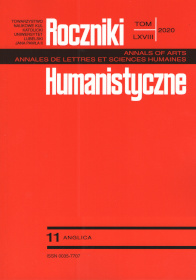Caribbean Landscape and the Construction of Creole Consciousness in Jean Rhys’s Wide Sargasso Sea
Abstrakt
Krajobraz Karaibów i konstrukcja kreolskiej świadomości w Szerokim Morzu Sargasowym
Artykuł analizuje powiązanie pomiędzy opisami miejsca a konstrukcją kreolskiej tożsamości w powieści Szerokie Morze Sargasowe autorstwa Jean Rhys (1966). Stawiam tezę, iż kreolska świadomość bohaterki powieści przechodzi ewolucję, której wyrazem jest jej relacja z naturą Dominki. Narratorka oddaje relację pomiędzy miejscem a tożsamością przywołując zdarzenia ze swojej przeszłości; szczególne znaczenie mają tu opisy jej interakcji z krajobrazem Karaibów na różnych etapach jej życia. Analizując powiązanie pomiędzy formacją tożsamości a krajobrazem Karaibów, artykuł ma na celu poszerzenie stanu badań nad procesem odzyskiwania pamięci w prozie Jean Rhys, jednocześnie rzucając nowe światło na kluczową rolę krajobrazu Karaibów w Szerokim Morzu Sargasowym.
Bibliografia
Antinucci, Raffaella. “Jean Rhys and the Duplicity of Landscape.” Scritture femminili: da Mary Wollstonecraft a Virginia Woolf, edited by Andrea Mariani, Francesco Marroni, and Massimo Verzella, Aracne, 2009, pp. 273–83.
Balaev, Michelle. “Trends in Literary Trauma Theory.” Mosaic, vol. 41, no. 2, 2008, pp. 149–65.
Caparoso-Konzett, Delia. Ethnic Modernisms: Anzia Yezierska, Zora Neale Hurston, Jean Rhys, and the Aesthetics of Dislocation. Palgrave Macmillan, 2002.
Drake, Sandra. “Race and Caribbean Culture as Thematics of Liberation in Jean Rhys’s Wide Sargasso Sea.” Wide Sargasso Sea, by Jean Rhys, edited by Judith L. Raiskin, a Norton critical edition, Norton, 1999, pp. 193–206.
Emery, Mary Lou. Jean Rhys at “World’s End”: Novels of Colonial and Sexual Exile. U of Texas P, 1990.
Erll, Astrid. “Locating Family in Cultural Memory Studies.” Journal of Comparative Family Studies, vol. 42, no. 3, 2011, pp. 303–18.
Eyvazi, Mojgan, Shirin Pourebrahim, and Nasim Sahebazmani. “Evaluation of Intertextuality and Irony in Jean Rhys’s Wide Sargasso Sea: A Postmodern Outlook.” International Journal on Studies in English Language and Literature (IJSELL), vol. 2, no. 9, 2014, pp. 153–64.
Gildersleeve, Jessica. “Jean Rhys’s Tropographies: Unmappable Identity and the Tropical Landscape in Wide Sargasso Sea and Selected Short Fiction.” Etropia, vol. 10, 2011, pp. 32–38.
Gregg, Veronica M. Jean Rhys’s Historical Imagination: Reading and Writing the Creole. U of North Carolina P, 1995.
Lai-Ming Ho, Tammy. Neo-Victorian Cannibalism: A Theory of Contemporary Adaptations. Palgrave Macmillan, 2019.
Loe, Thomas. “Landscape and Character in Jane Eyre and Wide Sargasso Sea.” A Breath of Fresh Eyre: Intertextual and Intermedial Reworkings of Jane Eyre, edited by Margarete Rubik and Elke Mettinger-Schartmann, Editions Rodopi, 2007, pp. 49–61.
Malissa, Inna bte Che Jamal, Hardev Kaur, and Manimangai Mani. “A Study of Displacement in Jean Rhys’ Novel Wide Sargasso Sea.” Advances in Language and Literary Studies, vol. 5, no. 5, 2014, pp. 111–18.
Mardorossian, Carine M. “Caribbean Formations in the Rhysian Corpus.” Jean Rhys: Twenty- First-Century Approaches, edited by Erica L. Johnson and Patricia Moran, Edinburgh UP, 2015, pp. 107–22.
Nora, Pierre. “General Introduction: Between Memory and History.” Realms of Memory: Rethinking the French Past, 3 vols., Columbia UP, 1996, pp. 1–20.
O’Connor, Teresa F. Jean Rhys: The West Indian Novels. New York UP, 1986.
Pyrhönen, Heta. Bluebeard Gothic: Jane Eyre and Its Progeny. U of Toronto P, 2010.
Rhys, Jean. Wide Sargasso Sea. 1966. Penguin Books, 2000.
Savory, Elaine. The Cambridge Introduction to Jean Rhys. Cambridge UP, 2009.
Söderberg, Emelie. “‘I Often Wonder Who I Am’: Identity, Landscape and Sexuality in Wide Sargasso Sea.” 15 Jan. 2010. Linnaeus U, student paper.
Weaver, Melanie B. Meeting the Madwomen: Mental Illness in Women in Rhys’s Wide Sargasso Sea, Hijuelos’s Our House in the Last World, and Garcia’s Dreaming in Cuban. 2012. East Carolina U, Master’s thesis.
Copyright (c) 2020 Roczniki Humanistyczne

Utwór dostępny jest na licencji Creative Commons Uznanie autorstwa – Użycie niekomercyjne – Bez utworów zależnych 4.0 Międzynarodowe.





